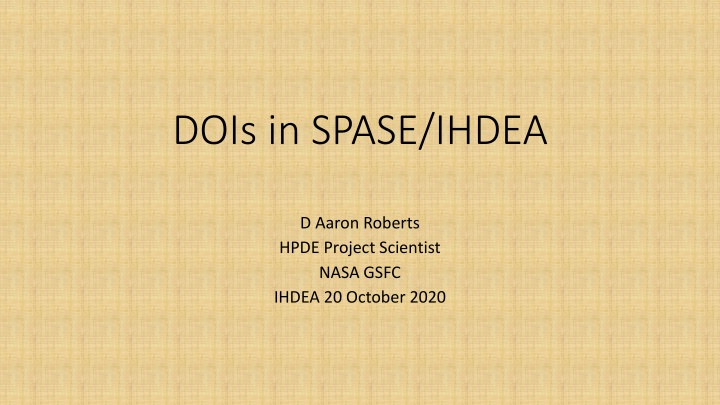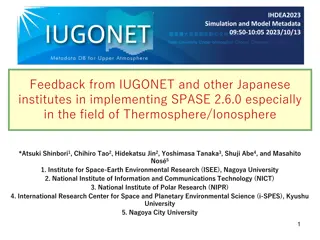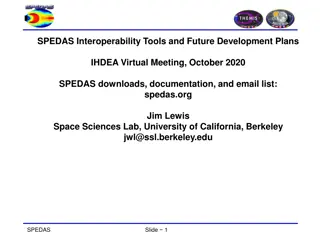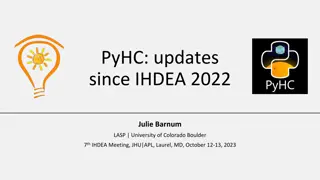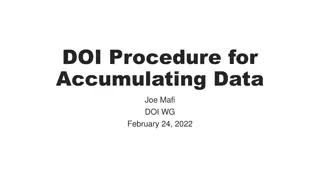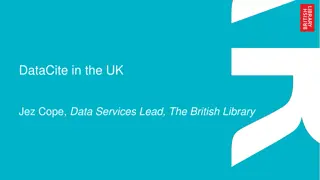DOIs in SPASE/IHDEA
Aaron Roberts is the Project Scientist at NASA Goddard Space Flight Center for the High-Performance Data Environment project. This initiative focuses on advancing data management and analysis capabilities within the field of Earth and planetary sciences, leveraging cutting-edge technology to enhance research outcomes and drive innovation. As the project scientist, Aaron Roberts plays a pivotal role in leading research efforts and fostering collaboration among multidisciplinary teams to address complex scientific challenges and unlock new insights into our planet and universe.
Download Presentation

Please find below an Image/Link to download the presentation.
The content on the website is provided AS IS for your information and personal use only. It may not be sold, licensed, or shared on other websites without obtaining consent from the author.If you encounter any issues during the download, it is possible that the publisher has removed the file from their server.
You are allowed to download the files provided on this website for personal or commercial use, subject to the condition that they are used lawfully. All files are the property of their respective owners.
The content on the website is provided AS IS for your information and personal use only. It may not be sold, licensed, or shared on other websites without obtaining consent from the author.
E N D
Presentation Transcript
DOIs in SPASE/IHDEA D Aaron Roberts HPDE Project Scientist NASA GSFC IHDEA 20 October 2020
DOIs and SPASE DOIs are routinely used for unique identifiers od journal articles or books, but they are now the de facto standard for registering datasets, in some cases nearly required by journals. Beneficial to all concerned, including readers who want to reproduce research and data providers who want an easy way to keep track of and get credit for data use. To help NASA s Heliophysics (HP) division with adapting to this change, the SPASE group (http://spase-group.org) is offering a service that makes acquiring a Digital Object Identifier easy for data providers.
Landing pages and an Example A DOI maps to a landing page a web page providing access and other information. We produce the Landing Pages from the SPASE product registrations, using a standard format for display. An example of a data product for which we already have minted a DOI would be cited as Russell (1987), with the bibliography entry (the specific format for the data reference will depend on the journal): Russell, Christopher T. (1987). ISEE 2 Magnetometer 1-min Data at CDAWeb. University of California at Los Angeles and NASA s Space Physics Data Facility. https://doi.org/10.21978/P8T923. Accessed from CDAWeb, 15 March, 2018.
Minting DOIs for NASA Entering the DOI URL in a web browser will bring up the product description. (Just click above.) Note that we have already compiled product descriptions for nearly all current and most past NASA missions, so all we need in order to mint DOIs for datasets is to get agreement with the missions on the publication information, namely, the title, creator(s), publisher(s), and publication year. (The creator is the author , i.e., the person or organization that made the dataset.)
Title and Creators For a typical resource with a SPASE record, we would retrieve the title from the ResourceName as it is in the description. Note that entering any unique piece of the SPASE ID in the text box of the HDP (https://heliophysicsdata.gsfc.nasa.gov) will find the resource, and clicking on its name will deliver the landing page. The creator(s) would typically be an instrument PI and perhaps other major contributors, but it is the decision of the product provider who should be included in the list. Teams or organizations (e.g., the WIND SWE team ) could be used as well, although they can also be taken as implicit. Creators are the people most directly responsible for the creation of the data product; they should agree with the list and the other aspects of the DOI information.
Publisher The publisher is the source of the data. Often data are served from a PI site, and more than one site can be noted if appropriate. If the data are in a major archive (e.g., NASA s Planetary Data System, Space Physics Data Facility, or Solar Data Analysis Center), that archive should be included as the publisher or co-publisher of the data; this will help to assure longevity.
SPASE record of DOI information Creators, publishers, and publication year will be in the SPASE entry PublicationInfo. However, nearly all of the resources descriptions currently do not include this information. As we collect the necessary information for minting a DOI we will update the resource description as well, and the latter will then provide the information needed by users of the DOIs for citations via listings or landing pages.
Location URL and Resource Type Minting a DOI also requires a location URL and type of resource, but these are taken care of by the SPASE team. The location URL is the SPASE metadata landing page at https://hpde.io, which is what the DOI link actually references. The type of resource is Dataset for NumericalData and Collection for DisplayData (there's an enumerated list of type choices). In the current repository of SPASE metadata there are ~2,000 NumericalData and ~150 DisplayData resource descriptions. Our goal is to assign a DOI to each described (NASA) resource.
DOIs in the IHDEA context NASA will only mint non-NASA DOIs if they are requested. Otherwise, we will use DOIs and SPASE entries as provided by the Creators of the dataset, or of the DOI, if different. (SPASE records will come from or be accepted by the Naming Authority.) Currently, ESA is minting DOIs at a more general level, that of the Experiment (e.g., CIS on Cluster), while NASA is producing DOIs for individual data products (datasets) given by a SPASE ID (e.g., a specific set of plasma moments produced by CIS on a particular Cluster spacecraft). There is no harm in having both types of DOIs (general and specific), with Schema-sanctioned Relationships (DOI A IsPartOf DOI B). We need to also work with JAXA and other DOI minters.
